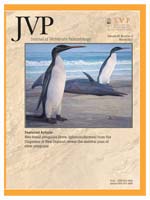Deposits from the Fossil Butte Member of the Green River Formation preserve exceptional fossils from one of the most diverse Paleogene avifaunas worldwide. Stem lineage parrots are well represented in this avifauna. Here we report a new species of Pan-Psittaciformes (crown clade parrots and their stem lineage relatives). The new species shares several features with extant parrots that are not present in the contemporaneous clades Halcyornithidae and Messelasturidae, including a wider pelvis, deeper trochlea cartilaginis tibialis, and larger pygostyle. Morphology of the foot suggests strong grasping ability and an arboreal ecology. Phylogenetic analysis of a combined data set of morphological and molecular sequence data resulted in limited support for a sister-group relationship between the new taxon and Quercypsittidae as well as a previously unrecognized clade including Vastanavidae, Halcyornithidae, and Messelasturidae. Regardless of whether this phylogeny or alternate hypotheses are preferred, a complex history of character evolution is inferred for key features related to the zygodactyl grasping foot within Pan-Psittaciformes.
How to translate text using browser tools
1 March 2012
A New Stem Parrot from the Green River Formation and the Complex Evolution of the Grasping Foot in Pan-Psittaciformes
Daniel T. Ksepka,
Julia A. Clarke
ACCESS THE FULL ARTICLE





